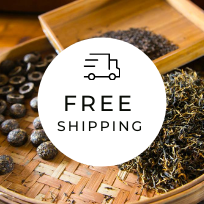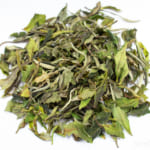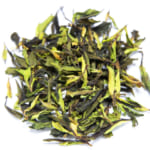- HOME >
- How to enjoy tea
Can we continue brewing tea next day after it’s been kept for a night?

In brewing tea, sometimes we discontinue brewing after only one or two infusions. We often wonder whether we should continue brewing it. Sometimes we may think that the brewing style like gong-fu brewing style or traditional Chinese brewing style or even the type of teapot will determine the duration that the tealeaf can remained fresh up to several brewing. From my point of view, with the same brewing style, the type of tea is the key determinant of the duration that the quality remains fresh. In this context, the type of tea is referring to the way of growing tea and not the category of tea. Some people may think that the green tea doesn’t last long in brewing while pu-erh tea can last for long brewing duration. In this article, I focus on Japanese green tea as my study model to look into the factors that determine the duration of brewing.
The growing method affects the deterioration speed
Tea grown in common tea garden that uses nitrogen fertilizer (regardless of it is organic fertilizer or chemical fertilizer) is usually spoils faster. After brewing and being left for 24 hours, this type of tea tends to produce off-odor like raw garbage. However, the natural farming tea that is grown without fertilizer remains fresh even after keeping it for the same duration. The brewed leaf of the natural farming tea does not produce unpleasant smell after 24 hours. On the next day we can continue brewing it. The unpleasant flavor of those non-natural farming tea is not caused by the microbiological spoilage but the oxidation of amino acid. The richer the amino acid content in the tea, the faster it produces the off-flavor.
The relationship between fertilizer and nitrogen in tea
The amino acid content in tea varies a lot and it is depends on the way the tea tree is grown. According to the data from the quantitative analysis, the more nitrogen-based fertilizer it is applied, the more amino acid the tealeaf contains per unit area. On the contrary, the poly phenol content decreases in proportion to the application of nitrogen-based fertilizer. If tea is grown with no or less fertilizer, the poly phenol content increases.
Comparison between naturally farmed tea and fertilized tea
We selected two different types of Japanese green tea to run the experiment to observe the effect of fertilizer. The right one is produced in the common tea garden that uses plenty of nitrogen-based fertilizer. I could taste overwhelming level of umami (taste of amino acid). Another one on the left is the tea grown in natural farming method, using no fertilizer at all. Initially, right after the first brewing, the tea grown with fertilizer was vivid green color. ① Once the nitrogen fertilizer is being applied, ②the nitrogen is absorbed into tealeaf, ③ it grows faster, and ④ more chlorophyll is being synthesized in order to conduct more photosynthesis. This is the mechanism that the tea grown with fertilizer becomes vivid green.
Observation of the brewed tealeaf
The left is the naturally farmed tea and the right is the tea grown with fertilizer. The steaming of the tea on the right is slightly deeper. We choose tea that both contain stems so as to adjust the condition. As the characteristic of naturally farmed tea, it gives yellowish green even if it is fresh.
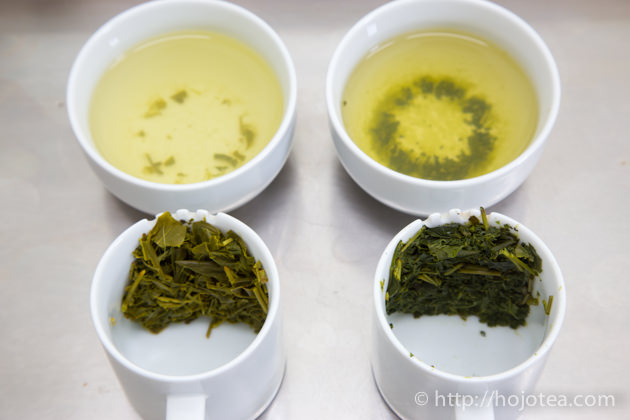
This photo was taken after 12 hours:The naturally farmed tea on the left was still giving very fresh-floral scent while the tea on the right losses its fresh flavor.

This photo was taken 24 hours later:The naturally farmed tea on the left was still giving very fresh floral scent while the one on the right was giving unpleasant flavor
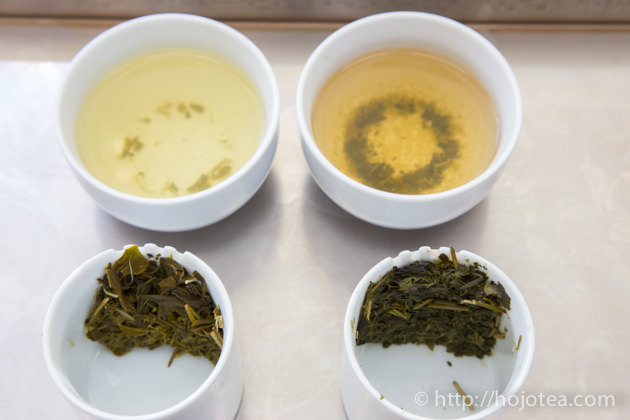
This photo was taken 36 hours later:Tea becomes a little cloudy. It shows that some microorganism grows at this stage. To my surprise, the naturally farmed tea was still giving quite refreshing scent
On the first day, the tea grown with fertilizer was very vivid green. In 12 hours later, it lost the brightness and vividness in color and it turns brownish after 24 hours. On the contrary, the naturally farmed tea steadily remains yellowish color from the beginning until the end without causing brownish change. As for the aroma, the naturally farmed tea was giving floral aroma after 12 hours, yet the tea grown with fertilizer lost its fresh aroma. After 24 hours later, the naturally farmed tea was still giving floral aroma, although it was not as fresh as right after the brewing. As the tea grown with fertilizer, it was giving unpleasant odor like rotten vegetable.

The color of tea liquor after 24 hours later: The naturally farmed tea (left) did not change its color much, yet the tea grown with fertilizer turned brownish color.
Umami leads the deterioration of tea
Tealeaf that contains less free-amino acid can remain its freshness and floral scent for a long time, even if the brewed tealeaf is left for long hours. The reason why the tea grown with fertilizer produced the unpleasant flavor was due to the maillard reaction. The maillard reaction is the oxidation of amino acid and sugar. The amino acid that is called umami involves in this reaction. In Japanese, umami is referring to the taste of amino acid. In Japanese, umami also means delicious taste. Due to the confusion in this term, it often leads a misunderstanding that the more umami means more delicious. In fact, umami is nothing but a term to describe the taste of amino acid. Umami has nothing to do with deliciousness. For us, and for many tea lovers in China and Taiwan, the aftertaste defines the tea quality. The tea grown without fertilizer is rich in poly phenol. Such tea gives very long lasting aftertaste, and in addition, its freshness remained for a long time.
I often continue brewing tea if it is within 15-16 hours, and this is only for the naturally farmed tea. Regardless of the type of tea, the only type of tea that I can enjoy its fresh flavor after it has been left for a night is the naturally farmed tea. Relatively, the freshness of oolong tea could last for a longer time, even if it is not naturally farmed tea. Oolong teas are plucked in later timing (when tealeaf grown bigger). It contains less amino acid but more poly phenol. If you need to be away during brewing tea, one of the best practices that I would suggest is to keep the brewed tealeaf in refrigerator. Thanks to the lower temperature, the speed of oxidation is slower. We can enjoy its freshness for a longer time.
Related Articles
How to get the latest update on HOJO Tea?
1. Follow Twitter, 2. Click "Like" on Facebook, and 3. Subscribe in newsletter. You can have the latest tea news from HOJO Tea.
 Subscribe the Newsletter to enjoy the privileges
Subscribe the Newsletter to enjoy the privileges- You may receive a free sample upon purchase, or you may have the priority to purchase special products. So please remember to subscribe our newsletter as well as the social network.
- Yunnan Chun Jian Green Tea from High Mountain Gardens
- Yunnan Chun Jian Green Tea is now available.This tea is made from naturally grown leaves harvested from high mountain gardens at 2100m above sea level. It has a rich, long-lasting lingering aftertaste, comparable to raw Pu-erh tea. Yunnan as a Distinctive Tea Growing Region Over the past 20 years, we have explored a wide range …
- Limited Loose Leaf Release of 2025 Da Xue Shan Wild Raw Pu-erh Tea
- We have released the 2025 loose-leaf version of Da Xue Shan Wild Raw Pu-erh Tea.This tea comes from wild tea trees that grow naturally in the high mountains of Yunnan Province, at elevations above 2000 meters. This year, we were only able to secure a small quantity for retail, and the current release is available …
NEW ARTICLES
 Yunnan Chun Jian Green Tea from High Mountain Gardens
Yunnan Chun Jian Green Tea from High Mountain Gardens- Yunnan Chun Jian Green Tea is now available.This tea is made from naturally grown leaves harvested from high mountain gardens at 2100m above sea level. It has a rich, long-lasting lingering aftertaste, comparable to raw Pu-erh tea. Yunnan as a Distinctive Tea Growing Region Over the past 20 years, we have explored a wide range …
 Limited Loose Leaf Release of 2025 Da Xue Shan Wild Raw Pu-erh Tea
Limited Loose Leaf Release of 2025 Da Xue Shan Wild Raw Pu-erh Tea- We have released the 2025 loose-leaf version of Da Xue Shan Wild Raw Pu-erh Tea.This tea comes from wild tea trees that grow naturally in the high mountains of Yunnan Province, at elevations above 2000 meters. This year, we were only able to secure a small quantity for retail, and the current release is available …
 2025 Da Xue Shan Wild White Tea Now Available from Yunnan
2025 Da Xue Shan Wild White Tea Now Available from Yunnan- The 2025 harvest of Da Xue Shan Wild White Tea is now available. Crafted from truly wild Camellia taliensis trees growing naturally in the high-altitude forests of Yunnan, this tea offers a purity and character unique to its origin. This year’s unusually dry climate during the withering season was ideal, resulting in a floral and …
 Why Do Some Teas Taste Astringent? Exploring the Causes and Mechanisms of Astringency
Why Do Some Teas Taste Astringent? Exploring the Causes and Mechanisms of Astringency- Tea can range from having no noticeable astringency to possessing a very strong one. What causes this astringency? This article explores the causes and mechanisms behind astringency in tea. Causes of Astringency Astringency arises from the binding of tea components to proteins in the oral cavity, creating a sensation of tightness or dryness. The tongue …
 The Impact of Heat Sources on Tea Flavor
The Impact of Heat Sources on Tea Flavor- It is widely recognized that the material of a kettle plays an important role in shaping the taste of water for brewing tea. Yet, an often overlooked but equally significant factor is the type of heat source used to boil the water. Different heat sources, whether gas, electric, charcoal, or wood fire, can impart distinct …
 New Release of High Mountain White Tea
New Release of High Mountain White Tea- We are pleased to introduce our High Mountain White Tea, sourced from a unique tea garden with two key features: 1. Located at an altitude of 2200-2300m2. Completely wild and untended The ideal natural conditions of this garden result in tea of exceptional quality, offering a pure and gentle, nourishing taste. High Altitude and Wild …
 New Release of Da Xue Shan Wild White Tea 2024
New Release of Da Xue Shan Wild White Tea 2024- We have released the 2024 Da Xue Shan Wild White Tea Loose Leaf. This tea was produced under our direct supervision during our stay in Yunnan Province, ensuring meticulous production management on site. Definition of Wild Tea in Yunnan Province People in Yunnan strongly associate Camellia taliensis with wild tea, regardless of where it is …
 New Release of Wild Pu-erh Jasmine Pearl
New Release of Wild Pu-erh Jasmine Pearl- Out of curiosity, we decided to create a jasmine tea based on Da Xue Shan Wild Raw Tea. This resulted in an exceptionally rare tea, not only in Japan but also in China. Custom Production Network for Jasmine Tea At our store, we source various types of base teas from different regions during the spring. …
 2024 Overview: Our Yunnan White Tea Quality, Process, and Weather Insights
2024 Overview: Our Yunnan White Tea Quality, Process, and Weather Insights- One of the teas we’ve been focusing on in Yunnan Province is white tea. Historically white tea has been produced in both Fujian Province and Yunnan Province for a long time. While white tea from Fujian Province is well-managed during processing, we are dissatisfied with the quality of the raw materials due to the use …
 Yunnan’s Hospitality Culture: Expressed Through Meals
Yunnan’s Hospitality Culture: Expressed Through Meals- In China, as a form of greeting, it’s common to say “你吃饭了吗?” which means “Have you eaten?” However, in Yunnan Province, the phrase “吃饭” is often used in various situations, more like “Eat, eat,” serving as an invitation to share a meal. Yet, with prolonged exposure to Yunnan, one comes to understand that these meal …
Shop Info

Address:Lot No. T-215, 3rd Floor, The Gardens Mall, Mid Valley City, Lingkaran Syed Putra, 59200 Kuala Lumpur
Tel: +603-2287-4537
Business Hour: 10am to 10pm
Category
- New Arrival at HOJO Online Shop
- Featured Articles
- Newsletter
- Types of Tea
- Origin of Tea
- Teapot and Tea Equipment
- Tea Column
- How to enjoy tea
- Tea Processing
- How to choose quality tea
- Tea constituents and functional effect
- Safety of Tea
- Foods
- Tea Business Operation
- Hobby and Outdoor Activity
- Ranking of Tea
- Video
- FAQ
- Media Release
Profile

- AKIRA HOJO
- I invite you to experience my tea selections.I was born in Nagano, Japan. In university, I studied agricultural chemistry, and I have the master degree in food science. I worked in Japanese food industry for 10 years. I involved in R&D, QC and QA. As a factory manager, I implemented ISO9000 series and managed the factory.
- The Art of Tea Magazine
- We posted the article on “The Art of Tea Magazine No.9, the magazine is published in Taiwan. We featured some scientific view about the tetsubin
- New Straits Times
- The Malaysian National Newspaper, New Straits Times featured HOJO Tea on 17-Oct-2007.




